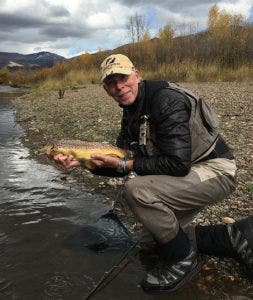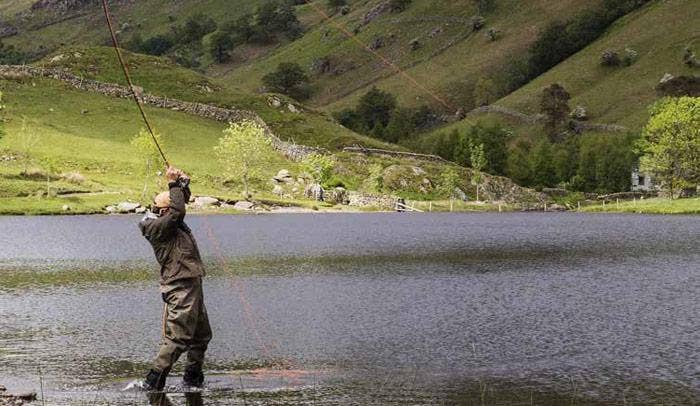Decisions, decisions, decisions… purchasing a single-handed fly rod is almost as angst ridden and loaded with nervous excitement and self-doubt as buying that first home or car, arguably worse. Why? Dreams, aspirations and hopes are bound up in that leap into the unknown and what doesn’t help is that there are few bad rods out there. Most are serviceable, many are impressive.
Charles' Top Considerations for Single-Handed Fly Rods
 Charles Jardine - UK Fly Fishing Personality
Charles Jardine - UK Fly Fishing PersonalitySo, where does one start? This single-handed fly rod guide focuses on three things that should guide you: your preference and gut feel, your budget, and the rod’s intended application and suitability for its intended task.
It is vital that you are comfortable with your purchase and much will depend on application, but does the handle fit? Does it accommodate your hand shape? If I am using 10ft, heavier line (#6-8) rods I personally am not a fan of short, western-style handles, especially without a small, cork fighting butt below the reel seat - but that’s just me, you may be different, but it is a consideration and just one of many.
Set yourself a price that you can comfortably afford, don’t be tempted to waver and go beyond it (as we know you will be). You will doubtless want a good fly line and fly reel with the purchase too, so work within a budget and feel comfortable about the outcome, both physically and fiscally. The overriding element is what and where you fish so let that be your guide. It is no use trying and falling in love with a beautiful rod that is hopelessly ill-suited to the waters you fish.
There are, of course, fly rods that cross the divide. A medium-to-fast action (see my action guide below) 9’ #5 or #6 rod will carry you around the world and embrace species from trout, sea trout, the odd Icelandic salmon (if you are fortunate), bonefish and a myriad of smaller sporting species. In trout terms, you can happily fish sizeable rivers, smaller stillwaters and, at a push, reservoirs. Don’t fall into the trap of seeing the antediluvian 2-piece rod as ‘sweeter’ than the prevalent 4-piece counterpart. Chances are it won’t be. Things have changed and a multi-sectioned rod is preferable in so many ways, not least transportation.
I could go on and on and descend into a lexicon of angling terms that would baffle and befuddle but what is the point? My view is that you should try a whole range and let your hands and wallet determine your decision - allied to the product technicalities offered by an impartial and knowledgeable sales assistant - Sportfish are first rate in this respect, they fish and they know their fly rods.

AS A RULE OF THUMB:
River Fly Rods
Small Rivers and Brooks
6’6” to 8’ rods in the #2-4 weight line category. Try lines with rods, you may feel that a #2 rod is best loaded for short casting with a #3 line (I am with Simon Gawesworth of RIO fly lines on this issue – double tapers!)Medium to Large Rivers
On chalk streams and freestone rivers such as the Wharfe, Usk and Clyde etc. Choose an 8’6” as a minimum, even extending to the more specialist 10’ #3-5, which is great for nymphing and classic wet fly fishing.Mayfly Season
Rivers are popular during this period and many anglers prepare for this one occasion only, but turning over a big, bushy Mayfly is NOT the place for delicate #2 fly rods. A 9’ #4 is better and a #5 will do a good job.Lake Rods
Small Stillwaters
You can get by with the shorter style of rod for stalking and clear water use, a 9’ #5-6 is perfect (so you can have a river rod, too) or you can use the longer rods – the 10’ #6/7. Much depends on your angling ersuasion, you MUST consider where you are going to fish and the styles of fishing you wish to adopt. There is no reason trying to get a 9’ #5 to propel a heavy, sinking line and a booby – it can be done, but gosh, what a struggle! Me? I love a 9’6” #5 but that is me being contrary.Big Reservoirs
Friends fish Grafham Water from the bank very effectively with a 9’ #5/#6. Would it be my first choice? No. Far better to use a 10’ #7 that will work well from the shore AND the boat. And let’s not forget the often overlooked 9’6” for #6 or #7 it’s a great length of rod and huge fun.Many prefer a 10’ #8 for the sheer ability to ping out a long line towards the horizon but remember the heavier you go, the less fun you will probably have. It’s your choice: expediency versus joie de vivre.
And of course, by selecting the last cluster of rods you have something very serviceable for sea trout and light salmon. Win-win.
Single-Handed Fly Rod Action Guide
Through action: The deeper the rod bends through its entire length, the slower the action and the wider the loop of fly line that is formed during the cast. Good for classic loch style drift fishing with a team of flies and near continuous roll casting a short line. Good too for wet fly fishing on rivers.The workhorse and common action attributable to most rods now is what is referred to as middle-to-tip. The rod bends less than the former and throws a happy balance of line loop, close and tight enough to travel, wide enough to alleviate tangles and provide delicacy – a brilliant all-rounder.
Last and by no means least, fast or tip-actioned. If you are reading this modicum of advice and guidance this action is probably NOT for you. This is a very personal rod action for experienced hands. Try it but be warned - tight loop heaven and ‘casting god’ status beckon - but fishing pleasure can diminish.
The only other consideration is the most vital, is it FUN to use? Does it meet the criteria that you want from a fly rod? If it puts a smile on your face after a few casts with the right line then it’s job done - as long as it’s within budget! I hope you found this single-handed fly rod guide useful!
Tight Lines,
Charles Jardine


